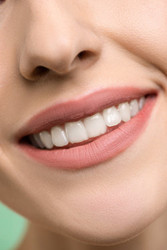What Are the Safest Ways to Whiten Teeth?
Jun 25th 2023

There’s no doubt that pristine, bright white teeth are a perceived sign of health and wellness. Teeth whitening is a huge industry, from dental office whitening services which can range from hundreds to thousands of dollars, to over-the-counter whitening products. These range from whitening toothpastes, gels, trays, strips and even whitening pens!
The Potential Downside of Whitening
There is a dark side to whitening your teeth though (no pun intended). Many whitening products rely on harsh bleaching agents to accomplish the stain-lifting and bleaching action needed to achieve whiter, bright teeth. Peroxide is often used, and although it can be safe and gentle enough at lower dilutions, there are often higher volumes of this ingredient in order to get the job done quickly.
The assumption is of course that all consumers expect near-instant results. And they aren’t entirely wrong, but I suspect if most people knew the dangers of whitening this fast, they would probably choose a much slower process that was a lot safer.
Activated Charcoal or Coconut Charcoal
Activated charcoal products contain the porous, mildly abrasive substance that can be derived from charcoal or even from coconut shells. The reason it can help whiten the teeth is because of its abrasiveness and scrubbing action. It is also thought to help “lift” stains since activated charcoal has a detoxifying and cleansing affect - it acts like a sort of sponge or magnet to soak up toxins, so the thought is it may also help to act like a sponge for stains.
There should be some caution used if you’re using any type of abrasive substance to whiten the teeth though. It can actually wear the layers or enamel off over time. Care should be taken not to scrub too hard. But this advice also applies even if you’re just using any toothpaste or tooth cleansing product along with a toothbrush to get your teeth clean. Related: MSM for Skin Lightening and Brightening
People who press too hard (I was guilty of this for years) can definitely start to experience thinning enamel over time. So if you use an abrasive product like this, then just don’t use it every single day. Take care to use a softer toothbrush, and really watch how hard you’re scrubbing. Your teeth and your gums will thank you for years to come.
Baking soda
Baking soda is another abrasive approach to whitening. It really only whitens because of the slightly abrasive nature of the product. Lots of people like to use this method because it’s inexpensive and totally natural. Plus, you can combine baking soda with your toothpaste of choice.
Baking soda has the added benefit of scouring up and eliminating odor and bacteria from the mouth. So it can really make your mouth feel clean and deodorized better than brushing alone. As with any other abrasive tooth whitening method, be sure to use care in how hard you’re brushing. And definitely go easy on the gum line. The gums don’t react well to hard brushing, and can even become irritated or start bleeding when too much pressure is applied.
Oil Pulling
We’ve written about the benefits of oil pulling previously if you’d like to read more about this overall dental and oral health ritual. In a nutshell, oil pulling is utilizing the oil of your choice and swishing it all around your mouth vigorously for about 20 minutes.
It’s called pulling because you are supposed to ‘pull’ the oil around the teeth and gums as best you can while it’s in there, really getting it in between the teeth. Some say that oil pulling has teeth whitening benefits among others. It may depend on the type of oil you choose as well, with some of the best results using coconut oil and sesame seed oil. People even use a drop or two of essential oils like rosemary or lavender when oil pulling, for an extra anti-bacterial punch. Related: Rosemary Oil for Improving Thinning Hair

